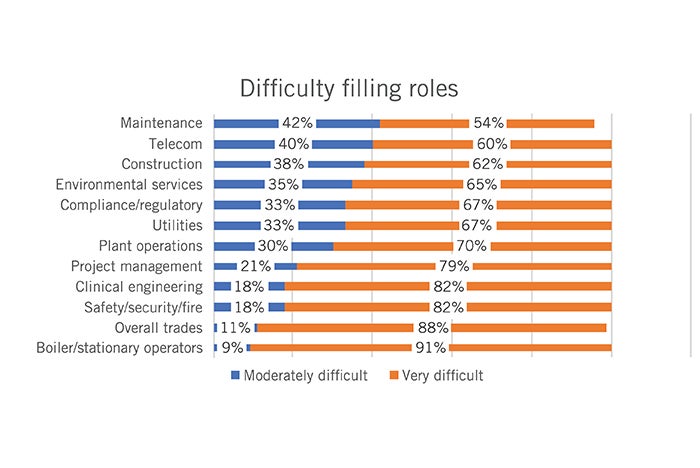Filling in-demand facility roles and positions

Note: Small percentages of respondents reported no difficulty in filling overall trades roles (1%) and maintenance roles (4%).
Data from the 2023 ASHE Membership Survey
Effective succession planning ensures safe operation and continued financial well-being of an organization. Often, succession planning exclusively involves the identification of a singular leader to replace a retiring leader. While this one-for-one role replacement is important, it fails to account for the market-level workforce factors that may change the overall needs of the organization. Furthermore, it does not consider how current workforce stability may impact future stability.
Effective succession planning should go beyond one-for-one successor identification and include three key activities.
First, leadership should gain an accurate understanding of the current workforce, knowing which roles and positions are well-staffed versus which roles and positions remain more difficult to staff.
Second, leadership should conduct an internal assessment to forecast how their own organizational and regional workforce may need to evolve due to market factors. Specifically, the organization should plot out exactly which roles will remain, be removed or need to evolve as these activities should directly impact recruitment, hiring and training practices.
Third, leadership should aim to understand their target workforce and potential pipelines so they can identify and implement best practices that allow organizations to attract, train and maintain qualified candidates.
Articles in this series on succession planning address each of these activities to assist facilities management professionals. Our research found that approximately a third of the workforce plans to retire within the next five years. Furthermore, it found that most of these empty roles will need to be staffed by a successor, and in some cases, the role will expand to include additional territory, supervisees or duties. The next step in this series is to explore data on which positions and roles are projected to be the most in-demand as well as the difficulty in filling these roles. The terms “roles” and “positions” are used deliberately because they combine to define a unique job title. A role is what someone does, and a position is the level at which they perform that role.
Effective succession planning includes an understanding and concrete plan to address the needs of both dimensions. For example, we know that approximately three-fourths of our retiring workforce will need to replace themselves, most of whom are at the director (56%) or manager (11%) position. As leadership considers candidates for these roles, they should identify skills gap content areas (e.g., leadership and budgeting) so that the next generation can acquire these skills, particularly if the goal is to promote an existing staff member into this higher position. Leaders also must identify where their organization might already have staffing shortfalls because, in most cases, these shortfalls will expand over time without a plan to recruit.
Respondents to the American Society for Health Care Engineering’s 2023 Membership Survey who were responsible for staff hiring and management were asked to report which roles they believed would be the most in-demand over the next five years. They also were asked to report how difficult (“not difficult,” “moderately difficult” or “very difficult”) each role has been for them to fill. As expected, respondents listed the trades roles as the most in-demand, followed by plant operations, maintenance and environmental services.
As a rule, respondents rated all the in-demand roles as difficult to fill. However, heating, ventilating and air-conditioning (94%) and plumber (92%) trades roles were the most difficult to fill, followed closely by positions listed on the graphic on this page, such as boiler/stationary operators (91%), safety/security/fire (82%), clinical engineering (82%), project management (79%) and plant operations (70%).
About this column
“Data Driven Insights” provides a primer on research basics and shares recent innovations and concrete answers by showcasing the collaborative applied research efforts of the American Society for Health Care Engineering members, academics and scientists and other related professionals working within complementary fields.
Lisa Walt, Ph.D., independent consultant in research and methodology.




